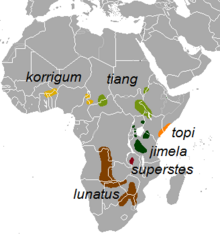Korrigum
| Korrigum | |
|---|---|

| |
| In Waza National Park, Cameroon | |
| Scientific classification | |
| Domain: | Eukaryota |
| Kingdom: | Animalia |
| Phylum: | Chordata |
| Class: | Mammalia |
| Order: | Artiodactyla |
| Family: | Bovidae |
| Subfamily: | Alcelaphinae |
| Genus: | Damaliscus |
| Species: | |
| Subspecies: | D. l. korrigum
|
| Trinomial name | |
| Damaliscus lunatus korrigum (Ogilby, 1837)
| |

| |
| Range in yellow | |
| Synonyms | |
The korrigum (Damaliscus lunatus korrigum), also known as Senegal hartebeest,[2] is a subspecies of the topi, a large African antelope.[1]
Taxonomy
An 1822–1824 British expedition across the Sahara to the ancient kingdom of
Description
Korrigan were said to differ from the tiang subspecies based on the tail tuft being more bushy, and the
Range and conservation
Korrigum formerly occurred from southern
Based on a 2004 estimation of the population of two national parks,
The 2004 population number used by the IUCN in 2016 is not the total population, but the IUCN claims that 95% of the total population occurs in these two parks.[1] The 95% claim appears to be a misreading of the 2004 report, in which it is stated that an estimated 95% of the range of the antelope in the country of Benin is estimated to fall within protected areas.[8] There was a large fall in population number in Waza NP before 2007. In 2013 korrigum were also found to continue to exist in northeast Ghana.[1]
Topi populations have also continued to occur in Zakouma National Park in Chad, as well as in the surrounding game hunting blocks outside the park,[9] where they have been growing.[10] The topi here are called korrigan[9] or tiang,[11] and have been assigned to the subspecies tiang.[11]
There are also large populations in the Niwa area bordering the
References
- ^ a b c d e f IUCN SSC Antelope Specialist Group (2 August 2016). "Damaliscus lunatus ssp. korrigum". Retrieved 31 August 2015.
- ^ OCLC 62265494.
- ^ OCLC 5266086.
- ^ Natural History Museum (BM) (19 April 2013). "Clapperton, Bain Hugh (1788-1827)". JSTOR. Ithaka. Retrieved 28 April 2021.
- PMID 24831669.
- ^ a b c IUCN SSC Antelope Specialist Group (30 June 2008). "Damaliscus lunatus ssp. korrigum". Retrieved 31 August 2015.
- ^ East, Rod; IUCN/SSC Antelope Specialist Group (1998). "African Antelope Database" (PDF). Occasional Paper of the IUCN Species Survival Commission. 21: 200–207. Retrieved 23 April 2021.
- ^ a b Chardonnet, Bertrand (November 2004). "An update on the status of korrigum (Damaliscus lunatus korrigum) and tiang (D. l. tiang) in West and Central Africa". IUCN/SSC Antelope Specialist Group Antelope Survey Update. 9: 66–76.
- ^ a b "Exclusive New Area Plains Game Hunt 1x1 / Chad". Book Your Hunt. 2021. Retrieved 29 April 2021.
- ^ "Chad - Main Details". Convention on Biological Diversity. United Nations Environment Programme. 2020. Retrieved 29 April 2021.
- ^ a b Capacity4dev Team (16 March 2017). "Parc de Zakouma, Tchad - Damaliscus lunatus". Capacity4dev. European Union. Retrieved 29 April 2021.
{{cite web}}: CS1 maint: numeric names: authors list (link) - ^ "Cameroon Savanna Hunt / Cameroon". Book Your Hunt. 2021. Retrieved 29 April 2021.
- ^ "Bouba Ndjidal National Park". European Union. 28 October 2010. Archived from the original on 12 April 2013. Retrieved 20 February 2013.

